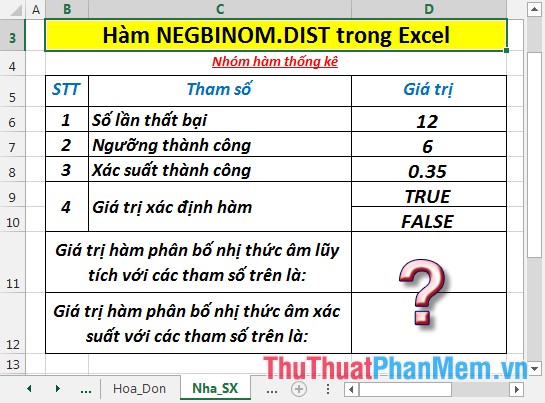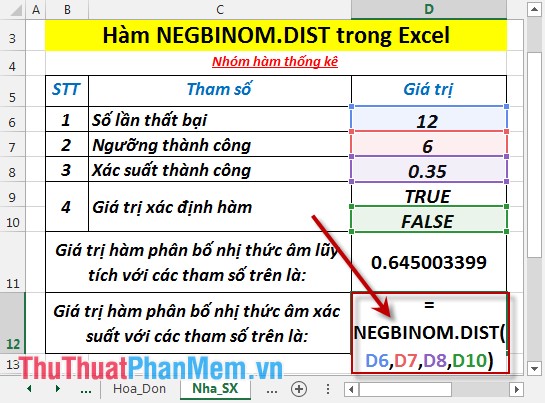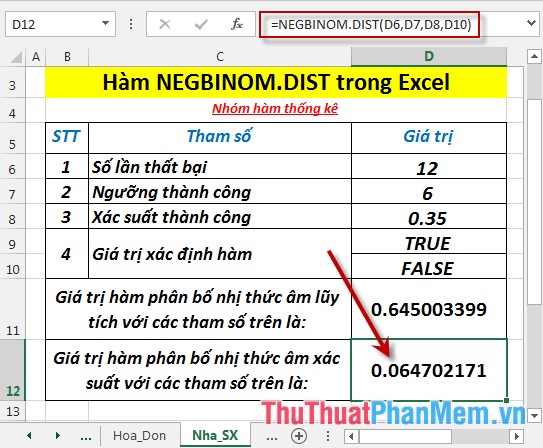NEGBINOM.DIST function - Function returns the negative binomial distribution in Excel
The following article introduces you to the NEGBINOM.DIST function - one of the functions in the statistical group is very popular in Excel.

Description: The function returns a negative binomial distribution, the probability that there will be Number_f failures before the number_s success attempt , with the probability of success being Probability_s . Support functions from Excel 2010 onwards.
Syntax: NEGBINOM.DIST (number_f, number_s, probability_s, cumulative)
Inside:
- number_f: The number of failures, is a required parameter .
- number_s: Threshold of success, is a required parameter.
- probability_s: Probability of success, is a required parameter.
- cumulative: A logical value that determines the form of the function, which is a required parameter, including:
+ cumulative = True -> returns the cumulative distribution function.
+ cumulative = False -> returns the probability density function.
Attention:
- If number_f, number_s are not integers -> they are truncated to integers.
- Any function argument except cumulative not a number -> function returns the #VALUE! Error value
- If probability_s <0 or probability> 1 -> the function returns the #NUM! Error value
- If number_f <0 or number_s <1 -> the function returns the #NUM! Error value
- The equation for the negative binomial distribution is:
[nbleft ({x; r, p} right) = left ({begin {array} {* {20} {c}}
{x + r - 1}
{r - 1}
end {array}} right) p ' {left ({1 - p} right) ^ N}]
Inside:
x is number_f, r is number_s, and p is probability_s.
For example:
Find the cumulative negative binomial distribution and the probability with the values in the following data table:

- Calculate cumulative negative binomial distributions (corresponding to True values ) . In a cell to calculate, enter the formula : = NEGBINOM.DIST (D6, D7, D8, D9)

- Press Enter -> cumulative negative binomial distribution is:

- Calculate probability binomial distribution (corresponding to False value ) . In a cell to calculate, enter the formula : = NEGBINOM.DIST (D6, D7, D8, D10)

- Press Enter -> negative binomial distribution probability is:

- There is a slight difference in value between cumulative negative binomial distribution function and probability negative binomial distribution.
Above are instructions and some specific examples when using the NEGBINOM.DIST function in Excel.
Good luck!
You should read it
- POISSON.DIST function - The function returns the Poisson distribution in Excel
- GAMMA.DIST function - The function returns the gamma distribution in Excel
- BETA.DIST function - The function returns the Beta distribution in Excel
- HYPGEOM.DIST - The function returns the hyperbolic distribution in Excel
- F.DIST - The function returns the probability distribution F in Excel
- T.DIST.RT - The function returns the Student's t-distribution on the right in Excel
- CHISQ.DIST - Function returns the distribution when squared in Excel
- LOGNORM.DIST - Function returns the logarithmic distribution of x in Excel
May be interested
- How to use the NORMDIST function in Excel - Function that returns the distribution in Excel
 the normdist function returns a distribution with a specified mean and standard deviation. the normdist function has applications in statistics, including hypothesis testing.
the normdist function returns a distribution with a specified mean and standard deviation. the normdist function has applications in statistics, including hypothesis testing. - BETA.DIST function - The function returns the Beta distribution in Excel
 beta.dist function: the function returns the beta distribution to study the variability of a number of things through a sample. support functions from excel 2010 onwards. syntax: beta.dist (x, alpha, beta, cumulative, [a], [b])
beta.dist function: the function returns the beta distribution to study the variability of a number of things through a sample. support functions from excel 2010 onwards. syntax: beta.dist (x, alpha, beta, cumulative, [a], [b]) - POISSON function - The function returns the Poisson distribution in Excel
 in predicting the number of events that occur within a specific time, one cannot help but use the poisson function. the following article details how to use the poisson function, the function returns the poisson distribution.
in predicting the number of events that occur within a specific time, one cannot help but use the poisson function. the following article details how to use the poisson function, the function returns the poisson distribution. - BETA.INV function - The function returns the inverse of the cumulative distribution function for a specified beta distribution in Excel
 beta.inv function: the function returns the inverse of the cumulative distribution function for a specified beta distribution. support functions from excel 2010 version. syntax: beta.inv (probability, alpha, beta, [a], [b])
beta.inv function: the function returns the inverse of the cumulative distribution function for a specified beta distribution. support functions from excel 2010 version. syntax: beta.inv (probability, alpha, beta, [a], [b]) - PHI function - The function returns the value of the density function for a normal distribution in Excel
 phi function: the function returns the value of the density function for a standard normal distribution. support functions from excel 2013 onwards. syntax: phi (x)
phi function: the function returns the value of the density function for a standard normal distribution. support functions from excel 2013 onwards. syntax: phi (x) - LOGNORM.INV function - The function returns the inverse of the logarithmic distribution of x in Excel
 lognorm.inv: the function returns the inverse of the logarithmic distribution of x. where ln (x) is usually distributed with parameter mean and standard deviation. use functions to analyze logarithmic change data. support function from excel 2 version
lognorm.inv: the function returns the inverse of the logarithmic distribution of x. where ln (x) is usually distributed with parameter mean and standard deviation. use functions to analyze logarithmic change data. support function from excel 2 version - T.INV function - The function returns the inverse value of the Student t distribution in Excel
 t.inv: the function returns the inverse value of the student t-distribution. support functions from excel 2010 onwards. syntax: t.inv (probability, deg_freedom)
t.inv: the function returns the inverse value of the student t-distribution. support functions from excel 2010 onwards. syntax: t.inv (probability, deg_freedom) - T.DIST.RT - The function returns the Student's t-distribution on the right in Excel
 t.dist.rt: the function returns the student's t-distribution on the right. functions used in testing the hypothesis of small numbers of data sets. support functions from excel 2010 onwards. syntax: t.dist.rt (x, deg_freedom)
t.dist.rt: the function returns the student's t-distribution on the right. functions used in testing the hypothesis of small numbers of data sets. support functions from excel 2010 onwards. syntax: t.dist.rt (x, deg_freedom) - F.DIST - The function returns the probability distribution F in Excel
 f.dist function: the function returns the probability distribution f. the function supports the version from excel 2010. syntax: f.dist (x, deg_freedom1, deg_freedom2, cumulative)
f.dist function: the function returns the probability distribution f. the function supports the version from excel 2010. syntax: f.dist (x, deg_freedom1, deg_freedom2, cumulative) - HYPGEOM.DIST - The function returns the hyperbolic distribution in Excel
 hypgeom.dist: the function returns the hyperinfection distribution, using this function for problems with finite sets of vowismooix observations whether or not they are successful. syntax: hypgeom.dist (sample_s, number_sample, population_s, number_pop, cumulative)
hypgeom.dist: the function returns the hyperinfection distribution, using this function for problems with finite sets of vowismooix observations whether or not they are successful. syntax: hypgeom.dist (sample_s, number_sample, population_s, number_pop, cumulative)










 CONFIDENCE.T function - The function returns the confidence interval of the population by using the Student's t-distribution in Excel
CONFIDENCE.T function - The function returns the confidence interval of the population by using the Student's t-distribution in Excel CORREL function - The function returns the correlation coefficient between two data sets in Excel
CORREL function - The function returns the correlation coefficient between two data sets in Excel COUNT function - Function that counts cells containing numbers in the list of arguments in Excel
COUNT function - Function that counts cells containing numbers in the list of arguments in Excel COUNTA function - The function performs counting non-blank cells in the list of arguments in Excel
COUNTA function - The function performs counting non-blank cells in the list of arguments in Excel COUNTBLANK function - The function performs counting empty cells in the list of arguments in Excel
COUNTBLANK function - The function performs counting empty cells in the list of arguments in Excel COUNTIF function - Function that counts the number of cells in a data table that meet certain conditions in Excel
COUNTIF function - Function that counts the number of cells in a data table that meet certain conditions in Excel